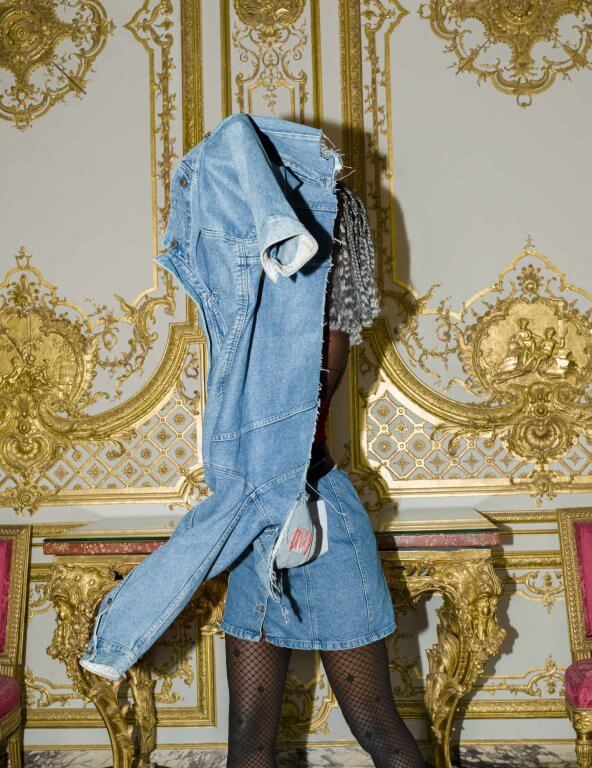Click here for more information about our corona protocol.
Eight years after her highly successful and acclaimed exhibition In and Out of Fashion, Viviane Sassen is returning to Huis Marseille with a monumental exhibition: Venus & Mercury, which will occupy all fourteen galleries as well as the museum garden. The exhibition was born in Versailles, where Sassen created new work inspired by various accounts of the French royal court in the 17th and 18th centuries. She wove these stories into a melancholic narrative drenched in eroticism, power, intrigue, illness, decay, and death. Sassen also created a number of new installations specially for Huis Marseille, including one based on the residential history of this Amsterdam canal-side house.
Venus refers to lust and love; Mercury to quicksilver
Numerous fascinating stories lie behind the exhibition Venus & Mercury in Huis Marseille. Many were inspired by the lives of Marie-Antoinette, royal mistresses, poisoners and soothsayers, as well as by the erotic and medical histories that surrounded the French royal court in the 17th and 18th centuries. Venus refers to the Roman goddess of love and lust, and Mercury to quicksilver, the heavy liquid metal that was long used to treat venereal diseases. Each gallery tells a separate story; together they form a linked sequence of remarkable histories, with accompanying poetic texts by Marjolijn van Heemstra. Some of these stories are related by the actress Tilda Swinton in a hypnotic video installation. Besides multimedia installations, the exhibition includes unique works created with paint and collage techniques, posters, and free-standing monumental pieces.
An illegitimate black daughter, a white cotton chemise, and other stories from the French royal court
A dark-skinned baby, reputedly the illegitimate daughter of the Queen of France – Louise Marie-Thérèse, who was born in 1664 – is one of the illustrious figures from the history of the French court that inspired Viviane Sassen to make a number of unique works treated with ink and paint and hung in the Garden Room at Huis Marseille.
Another inspiration was the simple, airy, white cotton gown in which Queen Marie-Antoinette was painted in the 18th century by Elisabeth Vigée-Le Brun, supposedly scandalous attire that caused a major furore. The dress inspired Sassen’s installation White Linen in the Upstairs Gallery. Several of the other galleries in Huis Marseille are also devoted to work inspired by events in the exciting life of a young queen who would ultimately lose her head at the guillotine. But Viviane Sassen gives these and other stories new and fascinating interpretations. In her hands a grand piano takes the form of a guillotine, and the queen’s secret letters are presented as fiery objects, the photos painted over with flaming colours symbolising the queen’s hidden passion for her supposed lover.
Interwoven stories
The history of Huis Marseille itself – an imposing canal-side house built in 1665 – includes the 17th and 18th centuries, and therefore overlaps the turbulent history of the court at Versailles. In the narrative of the exhibition Venus & Mercury Viviane Sassen let herself be inspired by the museum building and its own rich history, organically interweaving her work with the house. The Red Period Room contains a beautiful 18th-century ceiling painting by Johannes Voorhout. It is a mythological representation of Venus, the goddess of love, being presented to Mercury, the god of trade. In earlier times mercury – quicksilver – was used to treat syphilis. Sassen’s photographs of the false noses constructed for syphilis sufferers find a logical place in this room, and can be seen in a fresh light.
Eternal youth
With her photographs of teenagers, who are always amongst us, Viviane Sassen brings a modern touch to the age-old court. In the style rooms of the palace of Versailles, Sassen photographed three girls from the nearby town of Versailles: Charline, Blanche and Leila. In these images the undercurrent of lust and eroticism that flows through the whole of the Venus & Mercury exhibition takes a new, fresh, and multicultural turn. Viviane Sassen’s work visually blends the motifs of Charline and Leila’s artificial hair extensions with the frills of the gilded boiserie (profusely decorated wooden panelling) in the palace of Versailles, and their up-to-date denim jackets counterpoint the antique upholstery of the palace furniture. The Venus & Mercury exhibition also devotes a gallery to the history of Julia Valckenier (1680–1717), who lived at Keizersgracht 401 but who ended up in a house of correction at a young age thanks to her ‘debauched conduct’. These residential histories are described by Caroline Hanken in Een huis genaamd Marseille (2019), the source on which several of the histories Viviane Sassen has depicted in Venus & Mercury are based.
Viviane Sassen (1972, Amsterdam) is an internationally renowned artist known not only for her autonomous photography but also for her commissioned work in the fashion world. Sassen was awarded the Prix de Rome in 2007 and the Infinity Award of the International Center of Photography in New York in 2011. In recent years her work has been exhibited at numerous prestigious venues, including the 55th Venice Biennale (2013); The Hepworth Wakefield museum in Yorkshire, England; the Haus der Photographie in the Deichtorhallen in Hamburg; the Museum of Contemporary Photography in Chicago; the Institute of Contemporary Arts in London; and the Fotomuseum Winterthur. Sassen’s work was included in the group exhibition Visible / Invisible which ran from 4 May to 20 October 2019 in the Grand Trianon in Versailles, and which formed the first impulse for Venus & Mercury.









